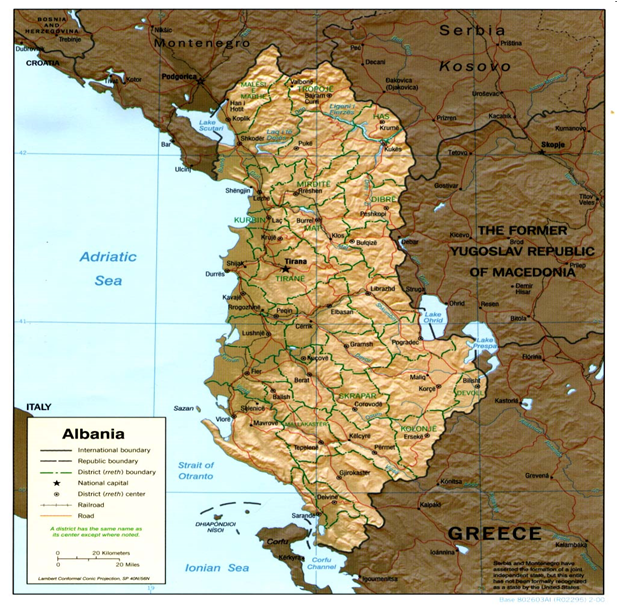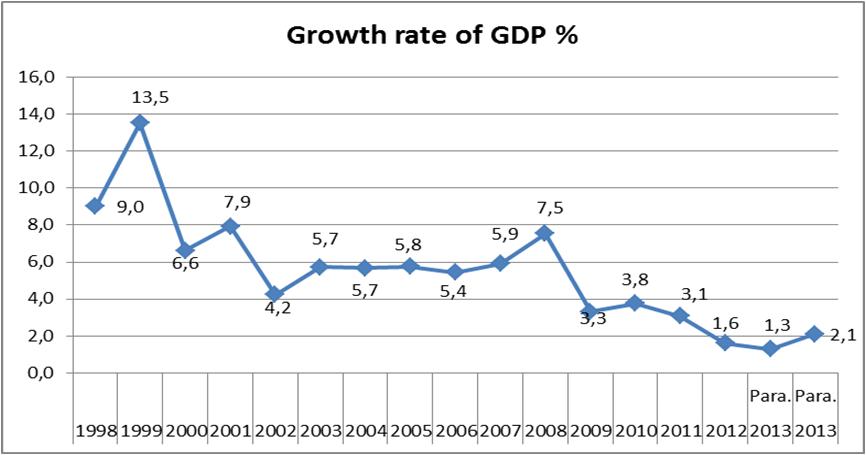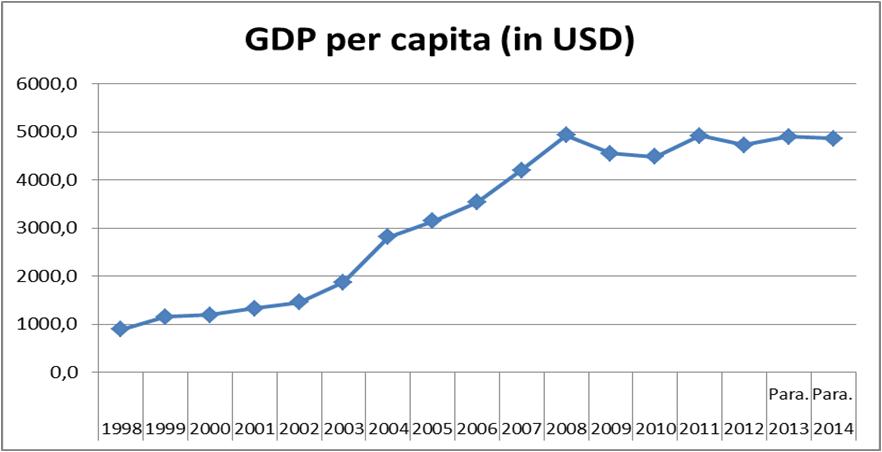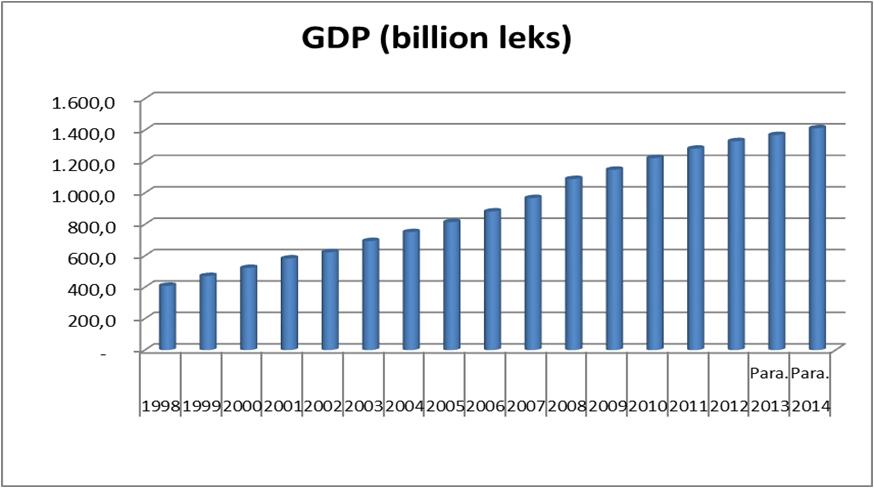General information about Albania
Geography
 Albania is a country in South-Eastern Europe, in the West of the Balkan Peninsula, between the geographical coordinates: 39 38′ latitudes and 42 39′ longitudes. Albania is almost midway between Equator and the North Pole, and covers a surface of 28.748 km2.
Albania is a country in South-Eastern Europe, in the West of the Balkan Peninsula, between the geographical coordinates: 39 38′ latitudes and 42 39′ longitudes. Albania is almost midway between Equator and the North Pole, and covers a surface of 28.748 km2.
The overall length of the borderline of the Republic of Albania is 1094 km, out of which 657 km are land-border, 316 km sea-border, 48 km river-border and 73 km lake-border.
The Republic of Albania is limited in the North with Serbia and Montenegro and Northeast borders with Kosovo, on the East with the Former Yugoslav Republic of Macedonia, and in the South and South-East with the Republic of Greece. On the West, the Adriatic and Ionian seas wash Albania. Albania is mostly a mountainous country. On the beautiful coast virgin and fine sandy and pebble beaches are to be found. The country is jeweled with plenty of beautiful inland lakes, natural lagoons, reserves, hunting grounds and SPA-s.
Climate
Albania is included in the humid sub-tropical zone of the Northern hemisphere, and it belongs to the Mediterranean climatic zone.
Albania is characterized by hot and dry summers, with bright sunny days and generally mild winters with abundant rainfalls.
In Albanian Alps in the northern part, the winters are cold and summers chilly. Normally the period from June to September is characterized by hot and sunny whether, while from October to May the weather is cool and wet.
Population
The population of Albania is about 2,800,138 people. Almost as many ethnic Albanians (3 million) live outside of the Republic of Albania. Albanian population is considered a young population. Its average age is 31.7 years old. After 1990 the population was faced with new phenomena like migration, which greatly affected not only the structure but also its growing rate. Population free and uncontrolled movements have affected the change of ration of urban population and that of rural population. In 2004 year the urban population has grown to 45 percent and the rural population is decrease from 57.3 percent in 2001 to 55 percent.
- Urbane : 1,498,508
- Rurale : 1,301,630
- Albanian 82.58%, Greeks 0.87%, others 16.55% (Vlachs, Roma, Serbs, Montenegrins, Macedonians, Balkan Egyptians, and Bulgarians).
Religions
- Muslim 56.7%,
- Albanian Orthodox 6.75%,
- Roman Catholic 10.03%.
- Albanian.
- males 74.95 years;
- females 80.53 years.
Infant mortality rate
- 29.90 deaths per 1,000 live births.
GOVERNMENT
- Parliamentary democracy.
- Adopted by popular referendum November 28, 1998.
- November 28, 1912
- Executive –President (chief of state), Prime Minister (head of government), Council of Ministers (cabinet).
- Legislative–140-seat unicameral People’s Assembly
- Judicial–Constitutional Court, High Court, multiple district and appeals courts.
- Universal at age 18.
Main political parties:
- Democratic Party (DP); Socialist Party (SP); Socialist Movement for Integration (LSI); Republican Party (PR); Demo-Christian Party (PDK); Union for Human Rights Party (PBDNJ); New Democracy Party (PDR); Social Democratic Party (PSD); ect.
MAIN MACROECONOMIC INDICATORS
| 2010 | 2011 | 2012 | 2013 | 2014 | |
| GDP (billion lek) | 1.222,5 | 1.282,3 | 1.330,0 | 1.369,0 | 1.412,0 |
| Growth rate of GDP % | 3,8 | 3,1 | 1,6 | 1,3 | 2,1 |
| GDP per capita (in US$) | 4.097,8 | 4.470,0 | 4.366,1 | 4.615,6 | 4.617,4 |
| Annual average inflation % | 3,6 | 3,5 | 2,0 | 1,9 | 1,3 |
| Exchange rate (lek/euro) | 137,7 | 140,5 | 139,0 | 140,1 | 139,5 |
| Trade balance (in % of GDP) | -20,8 | -23,1 | -18,9 | -14,5 | -12,4 |
| Current account deficit (in% of GDP) | -11,5 | -13,0 | -10,7 | -8,3 | -7,0 |
| Balance of payment (million Euro) | 179,0 | -28,7 | 77,3 | 146,5 | 216,5 |
Recent News
- Business offers from companies, members of the Federation of the Israeli Chambers of Commerce (FICC).AICC • 15 December 2017
- ALBANIA- ISRAEL BUSINESS FORUM TEL-AVIV DECEMBER.21.2015AICC • 9 December 2015
 Programi i vizites 27 Prill 2015 – 01 Maj 2015AICC • 5 March 2015
Programi i vizites 27 Prill 2015 – 01 Maj 2015AICC • 5 March 2015 Ekspozita dhe Konferenca e 19 Nderkombetare e Buqesise ” Agritech” Israel 2015AICC • 2 March 2015
Ekspozita dhe Konferenca e 19 Nderkombetare e Buqesise ” Agritech” Israel 2015AICC • 2 March 2015 Israeli Albanian Business Forum Tel Aviv October 2013AICC • 18 November 2013
Israeli Albanian Business Forum Tel Aviv October 2013AICC • 18 November 2013
Calendar
| M | T | W | T | F | S | S |
|---|---|---|---|---|---|---|
| 1 | 2 | 3 | 4 | 5 | 6 | |
| 7 | 8 | 9 | 10 | 11 | 12 | 13 |
| 14 | 15 | 16 | 17 | 18 | 19 | 20 |
| 21 | 22 | 23 | 24 | 25 | 26 | 27 |
| 28 | 29 | 30 | 31 | |||
Advertisement
Login
Shortcut Links
Login
More Info
AICC
Address: Rr. Frederik Shiroka , Pll.1, 2nd Floor , Office II, Tirana Albania.
Tel: +355 4 2281 79. +355 4 430 11 81,
Fax:+355 4 2245 512
Email:[email protected]




